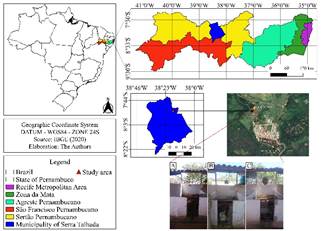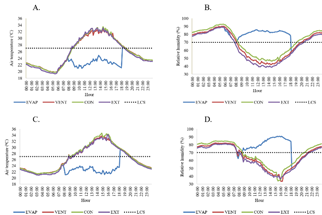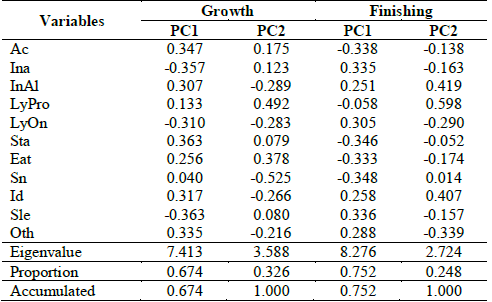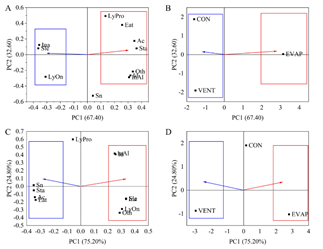1. Introduction
Thermal stress is a major environmental issue that negatively affects animal welfare and production efficiency in almost all sectors of livestock farming [4].
The Brazilian semi-arid climate covers 18.2% (982,566 km²) of the national territory and is characterized by the high availability of solar radiation, high air temperature, low relative humidity, and rainfall between 200 and 800 mm, concentrated in a few months of the year and distributed irregularly within those months. Even with the occurrence of this scenario, livestock farming is the predominant activity in the region, but is penalized by the thermal stress situations faced by pigs [6].
With the intensification of animal production, care must be taken with animal comfort, in a way that meets the basic requirements of animal welfare. When the animals are confined, the homeostasis mechanism becomes efficient only when the ambient temperature is within the comfort zone; therefore, it is essential to provide an environment capable of meeting the thermal requirements of pigs [17].
The definitions of animal welfare have been widely debated within the international scientific community over the past few decades. The most accepted conceptual line deals with this theme from a multidimensional perspective, covering emotional conditions, biological functioning, and natural behavior [3].
The thermal conditioning of the facilities, according to the physiological requirements of the animals, is directly affected by the external environment in intensive farming, which causes difficulty in maintaining the energy balance inside the facilities, in the expression of natural behaviors, affecting the swine productive and reproductive performance [16].
Therefore, the use of climate control systems in semi-arid regions of Northeast Brazil can improve environmental conditions, provide thermal comfort and, consequently, increase animal performance.
Because of the above, this research was conducted with the objective of thermally characterizing the facilities during the growth and finishing stages of pigs and evaluating the influence of climate control systems on the expression of the natural behaviors of pigs.
2. Material and methods
The research was carried out at the Swine Experimentation Facility at the Academic Unit of Serra Talhada (BES-UAST) of the Federal Rural University of Pernambuco, located in the municipality of Serra Talhada, Sertão, state of Pernambuco, Brazil (07°57'01” S, 38°17'53” W and altitude of 523 m) (Fig.1). According to Köppen’s climate classification, the region's climate is classified as BShw' ― semi-arid, hot, and dry, with rainfall occurring between the months of December and May. The annual averages of rainfall, temperature, and relative humidity of the region are 642.1 mm, 24.8 °C, and 62.5%, respectively [21].

Source: The Authors.
Figure 1 Map of the spatial location of the municipality of Serra Talhada and experimental pens. Control (A), Forced ventilation (B), and Adiabatic evaporative cooling (C).
The study was conducted in the spring of 2019, with 74 days of data recording. The animals were subjected to the following variation factors: pens without climate control system (CON), pens with forced ventilation (VENT), and pens with an evaporative adiabatic cooling system (EVAP), the last two were activated between 8 am and 6 pm, continuously.
Twenty-seven pigs (male and female) were used in the growth phase (64 to 100 days old), average live weight of 30.5 kg, from sows of commercial lineage for high deposition of muscle mass (– Duroc, ¼ Pietrain) of sows in the third order of birth, covered by a male of the Duroc breed (Pure Origin). The animals were kept under experimental conditions until the finishing phase (100 to 138 days).
The animals were housed in an experimental masonry shed with an east-west orientation. The facility has 330 m2 of total area, with nine pens of 2 x 3 m each. The treatments consisted of three non-consecutive pens, randomly defined, resulting in an available area of 2.0 m2 animal-1. Each pen contained 1 semi-automatic feeder for better control of feed consumption, made from galvanized sheet metal and 1 nipple drinker, installed 40 cm above the floor.
The nutritional management of the animals was carried out based on the concept of ideal protein, by development phase, following the nutritional requirements described by [18] for the production of animals with high genetic potential, as recommended in high-technology pig farming.
The feed was offered at will, distributed twice a day (morning and afternoon). The water supply for the animals was kept constant, with a flow rate of 3.0 L min-1.
The meteorological variables dry bulb temperature (°C), relative humidity (%), and black globe temperature (°C) were recorded using HOBO U12-12 data loggers (Onset Computer Corporation Bourne, MA, USA). In the production pens, the instruments were installed in the geometric center at a height of 0.6 m from the floor, and in the external environment, they were installed inside a meteorological shelter at 1.50 m from the ground, both recording every 10 minutes.
The behavior of the animals was evaluated through the analysis of digital images, at continuous time intervals of 10 minutes, every hour, between 8h00min am and 6h00min pm (totaling 100 minutes of daily observation per experimental treatment per animal), according to the methodology adopted by [19]. The behaviors expressed by nine animals in each treatment were analyzed once a week, during the experimental period.
The cameras were distributed in the shed to allow the monitoring of the animals in their respective treatments. The pigs were duly identified on the back with specific markers, to facilitate the observer's visualization.
Behavioral variables were analyzed by the ethogram based on research conducted by [12] and [10], in which the frequency of behavioral events in each behavior was determined.
The data were submitted to multivariate analysis, using the principal component technique (PC) to determine the correlations between the variables studied and the treatments used. For the validation of the PC, the criterion of [9] was adopted, in which it is assumed that the eigenvalues of the components must be greater than 1, for the projection of two-dimensional graphs. The Varimax rotation, that is, an orthogonal rotation, was applied to the principal components to obtain a better physical interpretation of the variables and to maximize the correlation of the variables and components [15]. The software program used for the analysis of principal components was OriginLab version 8.6.
3. Results and discussion
Pens equipped with the evaporative adiabatic cooling system showed significant results in reducing the temperature and increasing the relative humidity of the air, during the two phases of production of the animals (Fig. 2). These conditions were favorable to the thermal comfort of the pigs, which in these stages have a thermal demand between 18 and 26 ºC [7], with an upper critical limit of 27 ºC and relative humidity of 50 to 70%, so that they are kept under ideal housing conditions [14].

Source: The Authors.
Figure 2 Average hourly variation of temperature and relative humidity in the growth (A and B) and finishing (C and D) phases.
In the growth and finishing phases, at 2 pm, evaporative cooling reduced, on average, the air temperature by 7 and 10 °C, respectively (Figs. 2A and 2C), when compared to the temperature in the external environment. Likewise, when using an evaporative cooling system, [2] observed a reduction of 5.4 °C in air temperature, inside dairy cattle sheds.
Using geostatistical techniques, [1] observed spatial dependence between thermal comfort indicators and lower temperature and higher air humidity in the sector with the evaporative cooler, reaching a temperature reduction of approximately 5 °C, taking into account the maximum external temperature and the maximum variation obtained inside the facility, concluding that the evaporative cooling improved the environmental thermal conditions in the animals' housing.
Due to the peculiar characteristics of the semi-arid climate, the reductions obtained were more accentuated when compared to experiments in other locations with milder conditions, conditioned mainly by the low humidity of the air, which maintained an average condition of 50%, in the period in which the climate control system remained activated.
The effects of the evaporative adiabatic cooling system were also observed by [8], who confirmed its efficiency in maintaining thermal comfort.
Forced ventilation did not attenuate air temperature, since this system has the function of promoting the displacement of the air mass more quickly, resulting in the balance between internal and external temperatures, which in this case was not favorable to pigs, considering that the external temperature remained high throughout the study. For the pens without climate control system, a condition similar to the variation of the external environment was observed (Figs. 2A and 2C).
Table 1 shows components 1 and 2 (PC1 and PC2) of the meteorological and behavioral variables of the pigs. According to the criterion established by Kaiser (1958), the eigenvalues of the components were greater than 1; therefore, both components can be used for the projection of two-dimensional graphs.
Table 1 Analysis of Principal Components 1 and 2 for the Growth and Finishing phases.

Ac (Active), Ina (Inactive), InAl (Inactive alert), LyPro (Lying prone), LyOn (Lying on the side), Sta (Standing), Eat (Eating), Sn (Sniffing activity), Id (Idleness), Sle (sleeping), Oth (others).
Source: The Authors.
The total variance of PC1 was 67.40 and 75.20% for growing and finishing animals, respectively, while for PC2 it was 32.60 and 24.80% for growing and finishing animals, respectively. The total variance obtained by the sum of both components (PC1 and PC2) was 100% under both conditions of the animals. [22] studied the comfort conditions in 96 conventional pig farms, in the growth and finishing phases through the analysis of principal components, and obtained a total variance in the sum of PC1 with PC2 of 70.86%. These results are significant and corroborate that of the present study.
Based on the criterion of [9], the graphical representation of components 1 and 2 (PC1 and PC2), represented in Fig. 3, was plotted. The formation of two distinct groups is observed for growing animals (Figs. 3A and 3B), in which group 1 was marked in blue and group 2 in red. The same formation of the groups can be observed for the finishing animals (Figs. 3C and 3D).

Source: The Authors.
Figure 3 Principal components of the meteorological and behavioral variables of pigs in the growth (A and B) and finishing (C and D) phases.
Growing animals showed greater activity when subjected to the evaporative adiabatic cooling system (EVAP), since, when conditioned to a comfortable environment, they tend to have a higher frequency in standing posture (Sta) and eating (Eat) (Figs. 3A and 3B). Results obtained by [11] showed that pigs kept in high-temperature environments spent less time eating compared to those kept under thermal comfort.
On the other hand, the animals that were submitted to a ventilation condition (VENT) and the absence of a climate control system (CON), reduced the practice of standing activity and spent more time sleeping (Sle), when the animal's body has greater contact with the floor surface, seeking homeostasis through heat exchange by contact. This behavior also emphasizes the absence of the eating (Eat) behavior, as the animals reduce food consumption when they are under heat stress, which would cause a metabolic increase and an increase in body temperature.
[5] did not obtain a significant response when they tested different shower treatments in the pre-slaughter of swine, aiming to mitigate stress by temperature, attesting that this type of practice is not efficient to promote the welfare of animals; instead, the use of climate control system is more indicated during the rearing period. Sniffing activity (Sn) was not influenced by any of the treatments used.
During the finishing phase, it was observed that ventilation had a greater influence on the activity of the animals, both standing (Sta) and eating (Eat); therefore, it is preferable to use only ventilation for finishing animals, aiming at the economic viability of the production system.
On the other hand, the use of the evaporative adiabatic cooling system caused a reduction in the activity of the animals, and idleness (Id) and sleeping (Sle) were the ones that stood out the most. [13] considers the lethargic behaviors as typical of the finishing phase, in which the animals remain most of the time lying down, as they had greater body mass, which makes their locomotion difficult.
In the stalls that did not have a climate control system, controls, the animals remained sleeping for longer. This condition is observed through PC2. [12] relate the predisposition for maintaining the lying behavior associated with the increase in the ambient temperature, which justifies the practice of this behavior by the animals kept in the pens with forced ventilation and without a climate control system.
As a way to reduce heat stress, [20] observed that the behavior of pigs was directly affected by the temperature of the floor equipped with the climate control system, to promote comfort during sleeping time. More than 85% of the pigs were in the sleeping area when the floor temperature was below 26 °C, while only 15% of the pigs were in the sleeping area when the floor temperature was 30 °C, and there was hardly any when the floor temperature was above 33 °C, indicating the change in behavior shown by the animals when mild temperatures were provided.
4. Conclusion
Pens equipped with the evaporative adiabatic cooling system showed significant results in reducing the temperature and increasing the relative humidity of the air, during the two phases of production of the animals.
Pigs submitted to evaporative cooling showed a higher frequency of ingestive activity and wide lethargic behavior, typical of the studied phases.















